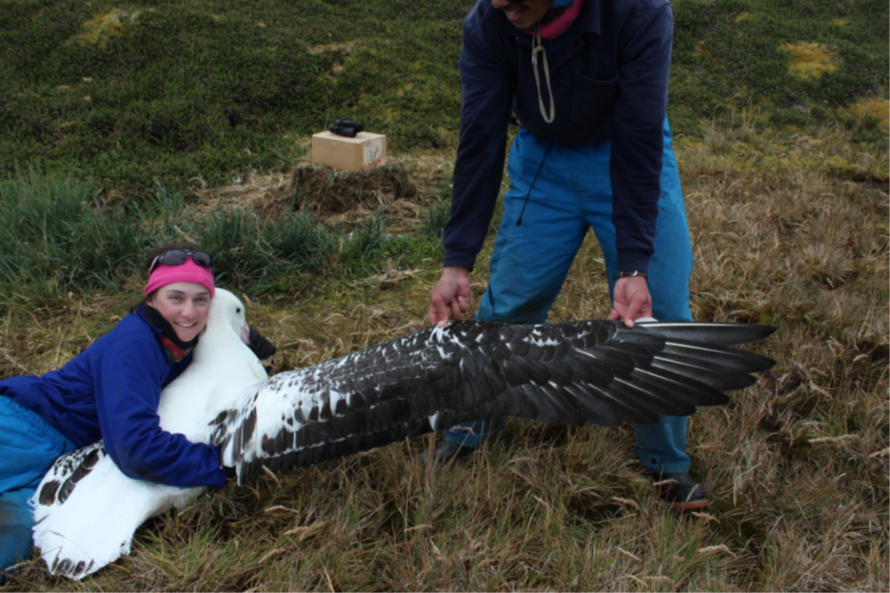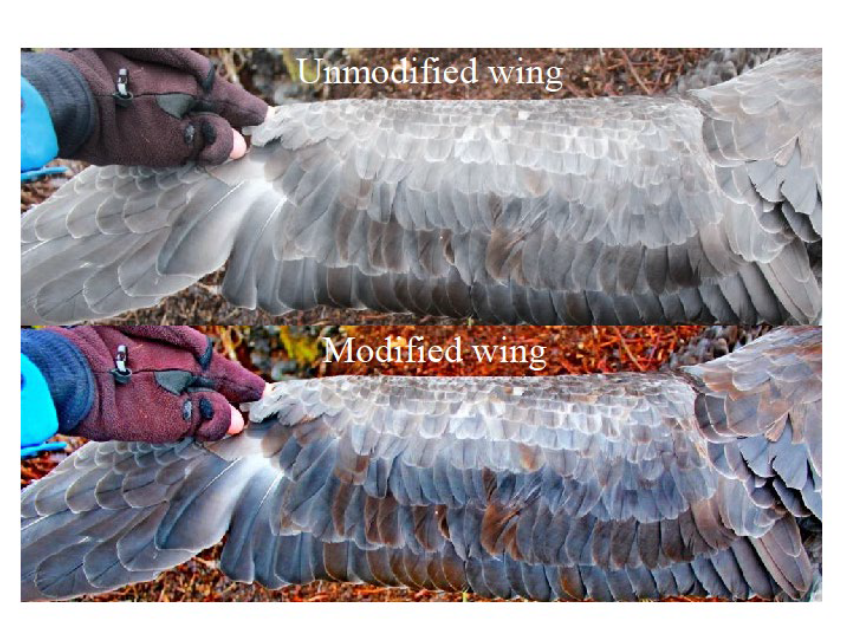l
Fieldworkers restrain an incubating Wandering Albatross at Marion Island for taking moult photographs under permit; the box on the nest protects the egg from Subantarctic Skuas; the publication notes that there was no evidence that photographing incubating Wandering Albatrosses and Northern Giant Petrels influenced their breeding performance
Alexis Osborne and Peter Ryan (FitzPatrick Institute of African Ornithology, University of Cape Town, South Africa) have published in the journal Ostrich Journal of African Ornithology on using digital photography to study wing moult of breeding Wandering Albatrosses Diomedea exulans and giant petrels Macronectes spp.
The paper’s abstract follows in English and French.
“Scoring moult from live birds in the hand takes time, thereby increasing the handling stress to the birds. We show that digital photography can be used to efficiently study moult extent across multiple feather tracts. We photographed the upper wings of incubating albatrosses and giant petrels to infer which remiges and greater secondary coverts had been replaced in the previous year. Wear contrasts differentiating ‘new’ from ‘old’ feathers were easier to see for dark than white feathers, and could be enhanced by increasing image saturation. Repeat photography of the same individuals in successive years showed that the inner secondaries and associated greater coverts wear faster than the central secondaries, and this needs to be considered when aging feathers of unknown birds. Scoring primary moult in the hand took more than twice as long as photographing the entire wing. There were a few discrepancies between moult scores from photographs and birds scored in the hand, mostly due to older feathers being scored as new. These errors likely resulted from rushing to score moult in the hand under indifferent lighting conditions. However, it is essential to ensure that the wing is fully spread, so that all feathers are visible. Photographing had no impact on hatching success and it is a useful and reliable method to study the extent and symmetry of moult.

The upperwing of a Northern Giant Petrel at Marion Island showing an unmodified (top) and modified (bottom) image, where the saturation was increased to exaggerate wear contrast differences; photographs from Alexis Osborne's MSc thesis
Utilisation de la photographie numérique pour étudier l’étendue de la mue chez les oiseaux de mer nicheurs
L’évaluation de la mue des oiseaux vivants dans la main prend du temps, ce qui augmente le stress de manipulation pour les oiseaux. Nous montrons que la photographie numérique peut être utilisée pour étudier efficacement l’étendue de la mue sur de multiples éstensions de plumes. Nous avons photographié les ailes supérieures d’albatros et de pétrels géants en incubation pour déduire quelles rémiges et grandes couvertures secondaires avaient été remplacées l’année précédente. Les contrastes d’usure qui différencient les ‘nouvelles’ des ‘anciennes’ plumes étaient plus faciles à voir pour les plumes sombres que pour les blanches, et pouvaient être améliorés en augmentant la saturation de l’image. Des photographies répétées des mêmes individus au cours d’années successives ont montré que les secondaires internes et les grandes couvertures associées s’usent plus rapidement que les secondaires centrales, ce qui doit être pris en compte lors du vieillissement des plumes d’oiseaux inconnus. L’évaluation manuelle de la mue primaire demande deux fois plus de temps que la photographie de l’aile entière. Des écarts ont été entre notées entre les marques de mue des photographies et les oiseaux marqués à la main, principalement en raison des plumes plus anciennes qui étaient marquées comme neuves. Ces erreurs résultaient probablement de la précipitation pour marquer la mue à la main dans des conditions d’éclairage indifférentes. Cependant, il est essentiel de veiller à ce que l’aile soit entièrement déployée, afin que toutes les plumes soient visibles. La photographie n’a pas eu d’impact sur le succès de l’éclosion et constitue une méthode utile et fiable pour étudier l’étendue et la symétrie de la mue.”
Read the abstract of Alexis Osborne’s 2020 MSc thesis entitled Understanding Moult Patterns in Albatrosses and Petrels breeding on Marion and Gough Islands” (Download the full thesis from here).
With thanks to Janine Dunlop, Niven Librarian, FitzPatrick Institute, University of Cape Town and Alexis Osborne, Gough Island Restoration Programme
Osborne, A. & Ryan, P.G. 2021. Using digital photography to study moult extent in breeding seabirds. Ostrich doi10.2989/00306525.2021.1897699 plus two photographs in supplementary information.
John Cooper, ACAP Information Officer, 22 May 2021

 English
English  Français
Français  Español
Español